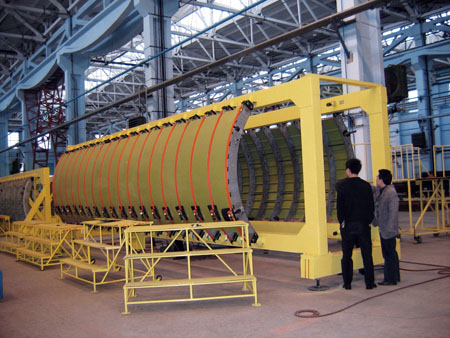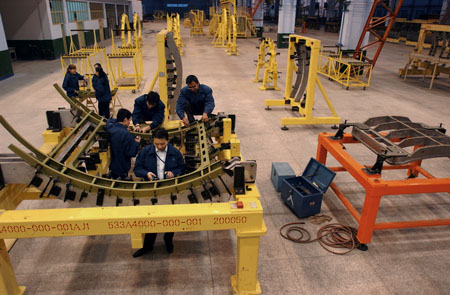
Lift-off for China’s regional jet
In China, an advanced regional jet aircraft is under production. It will be the country’s first civil aircraft with complete proprietary intellectual property rights, and it is generating interest worldwide.
Facts
AVIC1 Commercial Aircraft Co Ltd (ACAC) was founded in September 2002 to develop civil aircraft, a first for China. ACAC is in charge of mark-eting research and sales, customer service and the production of the ARJ21 jet aircraft. Relying on solid technological strength and an accurate understanding of market needs, ACAC aims to become a first-rank manufacturer of and service provider for civil aircraft.
The ARJ21 series includes the ARJ21-700 (the basic model, with 78 to 90 seats), the ARJ21-900 (a stretched version, with 98 to 105 seats), the ARJ21-700F (for freight) and the ARJ21-700B (a business jet). The aircraft is powered by two General Electric CF34-10A engines that are pod mounted at the rear of the fuselage. The cruise speed is 955 km/h and cruise altitude is 10,700 metres. Maximum speed is 1,005 km/h and maximum altitude is 12,000 metres. The standard aircraft has a range of 2,225 kilometres, and the extended range version has a range of 3,700 kilometres.
The aircraft’s performance parameters meet the diverse and demanding conditions in China, including the hot and high altitude conditions in western China.
A new jet is in the planning stages in China, and it looks likely to change the face of the country’s air industry. Called the ARJ21 (which stands for
“advanced regional jet for the 21st century”), it will be China’s first civil aircraft with complete proprietary intellectual property rights. The ARJ21 project has been under way in factories in Shanghai, Xi’an, Chengdu and Shengyang since the end of 2003, according to manufacturer AVIC1 Commercial Aircraft Co Ltd (ACAC). And if all goes according to plan, assembly work on the aircraft will begin early 2007, the trial flight will take place in March 2008, and delivery of the first ARJ21 to Shandong Airlines will occur in the third quarter of 2009.
“It was made clear from the very beginning that we would provide customers with both product and service, and we would always put the customer first,” says Lu Zheng, of ACAC’s marketing department. After the launch of the ARJ21 project, the first thing ACAC did was to meet with Shandong Airlines and determine the project details, including power systems, desirable equipment, customer service and similar factors.
China’s AVIC1 (Aviation Industry Corporation 1) is a state-owned manufacturer of both civilian and military aircraft. It runs the First Aircraft Institute, the institute responsible for the design of the jet.
Hu Zhonghui, senior engineer at the institute, is one of some 1,500 people involved in the design. “In the process of the design, we were aware of the gap between China’s civil aircraft design and manufacture and that of other countries,” he says. “However, we had confidence and pulled together with determination, always thinking about how to improve every
possible detail of the design.”
It is estimated that China’s aviation transport volume ranks third in the world, although almost all the planes currently in operation are imported.
China’s pursuit of the manufacture of civil aircraft has thus far been less than successful. In the 1990s, AVIC1 established a partnership with McDonnell Douglas to manufacture the MD-90 as a way to promote the development and manufacture of civil aircraft in China. Following McDonnell Douglas’s merger with Boeing, the company announced that it would discontinue production of the MD-90, bringing the cooperation to a halt.
AVIC1 later tried co-designing and manufacturing the AE100, a medium-sized aircraft, with foreign corporations, but this venture did not materialize for lack of technological independence.
AVIC1 determined that the only recourse was to manufacture China’s own civil aircraft with complete proprietary intellectual property rights.
In September 2002, AVIC1 joined 14 investors from aviation industrial institutes and enterprises to establish ACAC, headquartered in Shanghai, and launch the ARJ21 project.
In June 2005, four models of the ARJ21 aircraft in 1:10 size made a splash at the 46th aircraft exhibition in Paris. The ARJ21 cabin width is 3.14 metres – the most spacious cabin thus far in regional jet aircraft of this type, according to ACAC. Its cabin height of 2.06 metres and top luggage rack capacity make it as comfortable as large, trunk-line aircraft.
The ARJ21 is designed to be especially suitable for complex geographic environments that feature high plateaus and high temperature to ensure full-capacity landing and take-off in most airports of western China, says ACAC’s Lu.
The market prospects of the new plane are promising. Many airline companies have shown a strong interest in the ARJ21 for its low operating cost and high adaptability to airports and runways in western China. Orders for 35 aircraft have been secured even before the trial flight. Shandong Airlines, which will be the first airline to put the ARJ21 into service, has 10 aircraft on order. Shanghai Airlines has five on order, and Shenzhen Financial Leasing Co Ltd has 20 on order. In 2004, Xiamen Airlines signed a letter of intent to purchase six aircraft.
Experts point out that regional aircraft are now in great demand in China, and they predict that such aircraft will play a major role in China’s aviation transport industry. This will boost the development of the civil regional aviation market, especially in China’s western areas. Replacing larger planes on routes with fewer passengers will also solve the problem of surplus capacity and will help the development of new “point-to-point” airlines that serve popular tourist spots and booming medium-sized cities.
The selection and management of international suppliers is an important part of the ARJ21 project. As the major contractor, AVIC1 selected suppliers through a bidding process – a first for AVIC1. “As many as 20 suppliers of large components are involved, including GE, Liebherr, Rockwell Collins and Honeywell,” says Hu. This figure does not include standard parts and bearing suppliers, he says.
The ARJ21 is the first aircraft in China to be designed from the beginning to comply with airworthiness regulations of the General Administration of Civil Aviation of China, the US Federal Aviation Administration (FAA) and the Joint Aviation Authorities of Europe. Preparations for the establishment of the FAA’s Shanghai office began in November 2005, and the office is expected to begin operation toward the end of 2006, providing certification for the ARJ21. According to aviation officials, the ARJ21 will try to obtain FAA certification by the end of 2008, which will facilitate the aircraft entering the global market.
British Airways, Air France and other leading airlines recently visited ACAC and expressed their interest in the ARJ21’s spacious and comfortable cabin, evidence that the ARJ21 has garnered global attention.
“We have long-term blueprints for exploring overseas markets,” Lu says. “We are targeting such areas as Southeast Asia, South Asia and Africa, where the entry conditions are relatively favourable and the advantages of the ARJ21 suit the geographical environment.”
——————————————————————————–
Close cooperation
SKF is AVIC1 Commercial Aircraft Co Ltd (ACAC)’s largest bearing supplier. It also supplies ACAC with airframe rods.
SKF has custom-made some bearings for the ARJ21, including a spherical plain bearing used in the undercarriage. What makes this bearing special is its outer ring, which has a flange to facilitate mounting. After intense collaboration, SKF came up with a detailed design. “We are quite satisfied with the result,” says Hu Zhonghui, senior engineer at the First Aircraft Institute, run by China’s state-owned manufacturer of civilian and military aircraft, AVIC1 (Aviation Industry Corporation 1).
“Engineers from SKF Aerospace come to conduct technical exchanges,” he says. “They answer our questions about bearings and learn about our needs. For instance, we recently found during tests that a bearing was showing signs of serious wear and tear. SKF engineers helped to determine that this was due to insufficient lubrication and thus solved the problem.
“SKF provides us with high-quality products and reliable technical services,” he continues. “We are not only supplier and customer, but also good friends.”
The supply of seals and the scope of the two companies’ cooperation is likely to be broadened in the future.
by Elina Li
photo ACAC, SKF
Illustrations Leif Åbjörnsson






